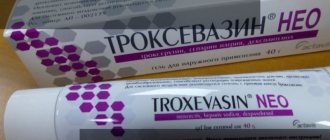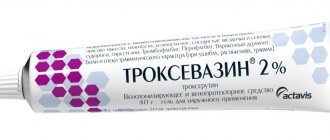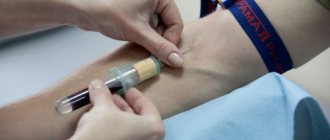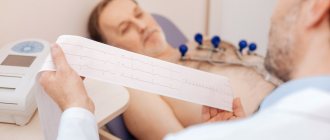Troxevasin is a widely known drug for venous insufficiency and other vascular pathologies.
The active substance of the drug is a synthetic analogue of the bioflavonoid rutin, or vitamin P, which has the following properties:
- antioxidant;
- healing;
- anti-inflammatory.
Troxevasin increases the tone of the venous walls and their density; reduces aggregation, or sedimentation, of platelets, and therefore prevents blood thickening and the formation of blood clots; reduces the permeability of vessel walls and thereby prevents the release of plasma into the tissue and the formation of edema.
Troxevasin is produced in two forms:
- in the form of yellow capsules in a gelatin shell (300 mg) for internal use;
- transparent yellow gel (2%) for topical use.
In addition to synthetic rutin, Troxevasin contains the following auxiliary components:
- Capsules: lactose monohydrate, magnesium stearate, colors E110 and E171, gelatin, quinoline.
- Gel: disodium EDTA, carbomer, triethanolamine, non-alkonium chloride solution, purified water.
When applied externally, the drug is well absorbed from the surface of the skin and a quick effect occurs.
When taken orally, it is quickly absorbed from the gastrointestinal tract, metabolized in the liver, and excreted by the kidneys and bile within one day.
It is prescribed for varicose veins, hemorrhoids, thrombophlebitis, phlebitis, phlebothrombosis, post-thrombotic syndrome, varicose dermatitis, edema and hematomas, etc.
Troxevasin is used in both forms for hemorrhoids.
What is Troxevasin
A medicine based on the angioprotective active substance troxerutin. Regulates the tone of capillary vessels and veins. It is used to eliminate pain, swelling and trophic disorders caused by their dysfunction.
Troxevasin is produced:
- in the form of an ointment for topical use: a viscous yellowish gel-like mass containing 2% troxerutin, packaged in 40 g tubes;
- in the form of capsules for oral administration: in a dosage of 300 mg of the active substance, gelatin, in blisters.
The product has a pronounced venoprotective effect. It helps reduce the permeability of vascular walls, improves blood outflow, prevents its stagnation in the lower extremities, prevents thrombus formation and the development of inflammatory processes. Troxevasin alleviates the underlying symptoms of varicose veins and slows down its progress.
The drug has five pharmacological effects
- Venotonic – reduces the stretching of veins, tension in the walls of capillaries, blood vessels and increases the movement of lymph.
- Antioxidant - inhibits the oxidation of hyaluronic, ascorbic acids and lipids, which leads to improved blood microcirculation and reduces the risk of blood clots.
- Angioprotective - reduces the permeability and fragility of small capillaries, increases the density of vascular walls and increases the transport of nutrients to tissues and organs.
- Anti-inflammatory - prevents the removal of fluid and blood cells from the capillaries, resulting in reduced swelling and inflammation.
- Antihemorrhagic - helps reduce pain and stop bleeding.
What is Troxevasin used for?
Medicinal ointment and capsules are prescribed:
- for chronic venous insufficiency;
- lack of nutrition of soft tissues caused by varicose veins;
- with postphlebitic syndrome;
- trophic ulcers;
- for symptoms of hemorrhoids;
- with retinopathy against the background of hypertension and diabetes.
The drug is used to prevent complications after surgical treatment of varicose veins, to prevent further vascular damage in the initial stages of pathology. Troxevasin is also indicated to improve well-being after mechanical injuries: bruises or sprains.
The active substance from the capsules is absorbed in the intestines. Its maximum concentration in the blood is observed 1.5–2 hours after administration. Metabolized by the liver and completely leaves the body within 0.5–1 day. Troxerutin from the ointment penetrates all layers of the epidermis, dermis and subcutaneous tissue within 3–5 hours.
During pregnancy
Hemorrhoids often develop during pregnancy. During pregnancy, most medications are contraindicated or limited, including Troxevasin.
It should not be taken in the first trimester and during lactation; in the second and third - if the effect of therapy exceeds the likelihood of complications in the expectant mother and fetus.
Troxevasin can be taken for hemorrhoids during pregnancy only in cases of severe congestion:
- inflammation of the nodes;
- pain, itching.
- difficulty with bowel movements.
When is Troxevasin contraindicated?
It is prohibited to take the drug orally:
- with exacerbations of ulcerative lesions of the gastrointestinal mucosa;
- some forms of gastritis;
- severe renal failure;
- increased sensitivity to the active or excipients of the drug.
The use of ointment should be avoided:
- if an allergic reaction to the drug develops: increased swelling, rash, severe burning or itching;
- with severe irritation, furunculosis, open skin lesions at the site of application of the product.
Contraindications
Troxevasin capsules and gel have contraindications:
- Oral administration is contraindicated in cases of hypersensitivity to rutin, exacerbation of chronic gastritis, stomach ulcers, duodenal ulcers, and during pregnancy (first trimester).
- The local remedy should not be used if you are hypersensitive or allergic to the components of the gel.
Troxevasin capsules and ointment are prescribed with caution for hemorrhoids:
- Children under 15 years old.
- For liver diseases.
- In case of renal failure.
If there is increased permeability of the vein walls, it is recommended to take Troxevasin against hemorrhoids along with vitamin C.
How to use Troxevasin capsules
The medicine should be swallowed with water, without chewing or crushing. Meal times don't matter. At the beginning of therapy, take 1 capsule. three times a day. Diabetic retinopathy and other severe conditions require up to 1800 mg (6 capsules) per day.
The course is continued for up to 15 days. After assessing the effectiveness of the dose, the dose is adjusted. It may increase or decrease. If the symptoms of the pathology subside, at the discretion of the doctor, therapy can be completed without a maintenance period. Otherwise, Troxevasin is taken for another 3-4 weeks.
Note!
The description of the drug Troxevasin on this page is a simplified author’s version of the apteka911 website, created on the basis of the instructions for use.
Before purchasing or using the drug, you should consult your doctor and read the manufacturer's original instructions (attached to each package of the drug). Information about the drug is provided for informational purposes only and should not be used as a guide to self-medication. Only a doctor can decide to prescribe the drug, as well as determine the dose and methods of its use.
How to use Troxevasin ointment
The drug is used externally: on clean skin over the lesion. A small amount of ointment is distributed over the body area in a thin layer, lightly rubbing it in until completely absorbed. After application, you can leave the skin open or apply fixing bandages, bandages, and put on compression stockings and bandages if necessary.
The procedure for applying the medicine is repeated twice a day: in the morning and in the evening. If this is not enough, do it more often. There is no need to specifically rinse off any remaining drug before applying again. The duration of treatment with ointment is up to 7 days. If there is no result or the physical condition worsens, the medicine is discontinued and another method of therapy is chosen.
Treatment of hemorrhoids after childbirth
Unfortunately, almost every woman in the postpartum period faces such a problem as hemorrhoids. It usually occurs due to excessive tension in the muscles of the perineum and stretching of the hemorrhoidal veins during the pushing of the woman in labor. It has been noted that the development of hemorrhoids can begin during pregnancy, which is facilitated by weight gain and a sedentary lifestyle. In this regard, it is recommended to carry out regular prevention of hemorrhoids both during pregnancy and in the postpartum period. Often it is pregnancy and childbirth that become the very catalyst that provokes the development of hemorrhoids. And there are a number of reasons for this.
Causes of postpartum hemorrhoids
Firstly, during pregnancy (usually in the second and third trimester) and especially during childbirth (of course, if they occur naturally), the pressure of the enlarged uterus and fetus on the rectum becomes simply colossal, while blood flow to these places becomes much more difficult. When pushing, the sphincter muscles experience particular overload. This also includes intra-abdominal pressure, which is increased in most pregnant women in the later stages, not to mention situations where there is a multiple pregnancy.
Quite often, a pregnant woman may have only minor symptoms, but during childbirth, when intra-abdominal pressure rapidly increases, nodules and fissures can form. The severity of the lesions in this case depends on the individual characteristics of the woman in labor, the weight of the child, and the course of labor.
Frequent constipation can also provoke the appearance of hemorrhoids, which, alas, is not at all uncommon in pregnant women. This is due, first of all, to an increased amount of progesterone - the so-called pregnancy hormone, which can cause various kinds of digestive disorders, and also contribute to a slight weakening of the tone of the walls of blood vessels, which is fraught with more severe stretching of them, and mild intestinal atony. As a result of the described changes, the digestive process in a pregnant woman becomes slower, thereby causing constipation. Constipation, in turn, increases pressure on the rectum and contributes to blood stagnation. This results in the appearance of characteristic hemorrhoids (pictured).
Among other reasons leading to the formation of hemorrhoids, one can also highlight nutrition with foods that contain insufficient amounts of fiber, excess body weight (not only during pregnancy, but also before and after it), bad habits (smoking and alcohol), constant sedentary work, lifting heavy objects without proper training, as well as the use of hormonal drugs, which are often prescribed by doctors for complicated pregnancies. Therefore, it is advisable to think about all this even before pregnancy and childbirth.
It is especially worthwhile to be attentive to those women whose families have relatives who were or are suffering from hemorrhoids. In this case, there is a high probability that insufficient elasticity of the veins and, as a result, the risk of developing hemorrhoids, is a hereditary trait in your family.
Characteristic signs of hemorrhoids
At the very beginning of the development of the disease, at its first stage, characteristic signs indicating the presence of hemorrhoids are:
- discomfort in the rectum (pain, heaviness, itching, burning);
- the presence of blood in the stool after defecation;
- increased body temperature;
- general malaise;
- signs of intoxication of the body.
Subsequently, as the rectal veins enlarge, peculiar “bumps” or hemorrhoids are formed, which were mentioned just above. Their appearance is characterized by the second stage of the disease. All this is accompanied by pain (sometimes very pronounced) and inflammation. Particularly painful and prone to complications are internal hemorrhoids , when the nodes are located inside the anal canal. External hemorrhoids , despite their unesthetic appearance in terms of pain and complications, cause less trouble.
The second stage during pregnancy can persist for a fairly long period of time, however, undetected and untreated hemorrhoids during childbirth can progress to the next, third stage, which is characterized by the prolapse of nodes from the anus. If appropriate measures are not taken in time, the disease will progress to the last fourth stage, when it is almost impossible to move the hemorrhoids inward manually; they significantly increase in size, constantly bleed and become inflamed.
What are the dangers of hemorrhoids after childbirth and how to deal with this problem correctly?
You should know that hemorrhoids can occur not only during pregnancy, but directly during childbirth. Be that as it may, in the postpartum period, hemorrhoids can make the body even more vulnerable than usual. Therefore, it is so important to monitor your health so as not to trigger the development of the disease and promptly seek help from a specialist. It is known that after pregnancy and childbirth, a woman’s immune system needs some time to fully restore the body’s defenses. During this period, a disease such as hemorrhoids, for example, can only weaken them further. Let's add here the problems of caring for a child and breastfeeding him. Indeed, when the disease worsens, the bleeding that occurs in a young mother can contribute to infection with dangerous infections. There is also a high probability of developing anemia, paraproctitis, thrombophlebitis, and even necrosis of the external hemorrhoid when it is pinched. In addition, we should not forget that, based on numerous medical studies, hemorrhoids are recognized as one of the indirect causes of cancer. This should be taken into account by all those who consider hemorrhoids to be a minor disease that should not be paid attention to. Hemorrhoids will not go away on their own; they must be treated! Experienced proctologists at the ViTerra .
In the postpartum period, treatment of hemorrhoids is usually extremely gentle. Even at the third or fourth stage, when treatment of external hemorrhoids is already necessary, if the patient’s condition allows it, they try to postpone the time of surgical intervention to a later date.
What can help reduce the symptoms of the disease?
Typically, hemorrhoids after childbirth occur in an acute form: first there is itching, burning, discomfort, and a feeling of heaviness in the anus. Over time, the pain increases more and more, bleeding appears during the act of defecation, which can provoke anemia, which is especially undesirable for a woman after childbirth. Hemorrhoids increase significantly in size and they fall out. Every movement for a woman turns out to be very painful, it is difficult for her to walk, sit, even the act of defecation becomes extremely painful. The anal area becomes inflamed and cracks appear. In this case, immediate treatment is necessary.
- The first step is to improve your diet. This will not only ease the course of hemorrhoids, but will also be beneficial for the child, especially if the woman is breastfeeding.
- You can and should use local remedies that can cure hemorrhoids at home. Herbs, decoctions, tinctures - all of this can be used as external remedies for hemorrhoids.
- It is also worth making sure that you do not remain in an upright or sitting position for a long period of time. It is advisable to find at least a few minutes a day for special gymnastics, which helps strengthen the muscles in the pelvic area.
- Any medications should be taken with extreme caution. If your baby is breastfed, do not take any medications without first checking with your doctor. Only a qualified specialist will be able to prescribe medications that will not pass into your baby’s milk and, therefore, will not cause harm to his body.
- You should also be careful when using laxatives, which are often recommended for hemorrhoids. For pregnant and lactating women, such drugs are strictly contraindicated.
- Make an appointment with a proctologist at clinic No. 1 ViTerra Belyaevo, and then you can be sure that your health and the health of your baby are completely safe! The doctor will conduct an examination and prescribe you appropriate treatment, including the use of suppositories, ointments or tablets for hemorrhoids, recommend you a proper diet rich in fiber and avoid the problem of constipation, and also suggest walking more and doing a number of exercises to strengthen the pelvic muscles. Remember that if you have any suspicions about hemorrhoids, you should avoid wearing tight underwear, do not lift heavy objects, and do not put off visiting a specialist.
Prevention of hemorrhoids after childbirth
Prevention of hemorrhoids is an effective technique that, if it does not help to completely avoid postpartum hemorrhoids, will at least prevent its severe course. Such preventive measures should be carried out during pregnancy.
1. Women who are expecting a baby are advised to carefully monitor their diet to avoid constipation and other problems.
2. They should diversify their diet with natural food, fresh vegetables and fruits. Coffee, chocolate, pastries and fatty foods are best avoided. You should also avoid spicy foods, which can irritate the rectal mucosa, and legumes, as they cause severe gas formation.
3. When preventing hemorrhoids, the correct daily routine is considered very important. It is recommended to visit the toilet at the same time, preferably in the morning. During bowel movements, you should not push too hard so as not to provoke swelling of the hemorrhoidal veins. In addition, it is very important to maintain personal hygiene. Doctors advise that after each bowel movement, wash yourself with clean, cool water and wipe the anal area dry with soft toilet paper or a towel.
4. An important point in the prevention of hemorrhoids, especially postpartum, is physical activity. Despite the fact that heavy loads are contraindicated for pregnant women, light exercises will only benefit them. In addition, pregnant women are advised to walk a lot in the fresh air, which will not only help prevent hemorrhoids, but also strengthen the immune system.
5. Another method of prevention is Kegel exercises . Their essence is to alternately tense and relax the muscles around the anus and vagina. If you perform such exercises regularly, you can prevent not only postpartum hemorrhoids, but also uterine prolapse and laxity of the vaginal muscles.
As a parting word
We wish each of you that your postpartum period will be filled only with the most wonderful moments and joyful worries about your baby growing up every day, and not with sad thoughts and worries about how to independently cope with alarming symptoms that indicate the development of hemorrhoids.
Don’t let the disease get worse, love yourself and be extremely careful and attentive to the issue of maintaining your own health and, as a result, the health of your baby!
Analogs
If you are individually intolerant to the drug in question (or if the inflamed nodes have not become smaller after 2 weeks), the doctor will prescribe a substitute. There is a wide range of medications on sale with a similar mechanism of action.
The closest analogues of troxevasin:
- "Heparin ointment";
- "Phleboton";
- "Troxerutin";
- "Troxegel";
- "Venorutinol".
It is safer to delegate responsibility for selecting a pharmaceutical product to a doctor. Self-medication can be dangerous to health.









